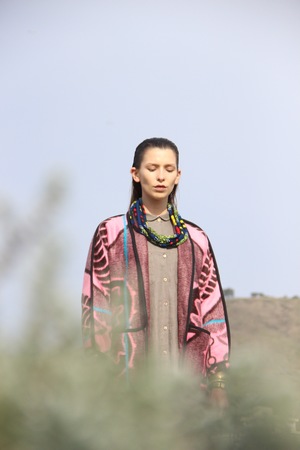Contrary to common knowledge, Cape Town is actually one of the fashion capitals of Africa, and of the world. But in a city bordered on one side by picturesque beaches and flanked on the other by a wonder-of-the-world mountain, the last thing you’ll find here is fashionistas traipsing around the streets in ostentatious fur coats and high-end jewelry.
Cape Town is a place of stark contrasts – one block may shelter homeless people taking refuge on the sidewalks, cocooned in a mess of blankets and bags, and another street five minutes away may showcase some of the most expensive real estate on the continent. The well-off here seem to invest their wealth more in chic houses and expensive cars than clothes that boast status. Why? Maybe it’s a question of safety – dangling a Louis Vuitton bag on your arm in public can make you a target, someone who may also have plenty of cash and an iPhone stowed away.
 WEISS Cape Town’s iconic Lesotho blanket coat, photographed by myself.
WEISS Cape Town’s iconic Lesotho blanket coat, photographed by myself.
Or maybe it’s a matter of taste. The city houses a burgeoning local fashion and lifestyle industry; with distinctive work on offer from highly skilled artisans and entrepreneurs, mainstream brands become boring. Why purchase a Céline bag when you could get a springbok purse made by a local father who works to send his daughter to school? Why buy Burberry when there’s a more unique coat down the road, created by a local designer with an exceptional eye?
Shopping local does not even have to be expensive. My springbok bag, made entirely from thick, genuine leather, cost me $40. A one-of-a-kind coat made by a local fashion designer from blankets the indigenous Sotho wear will go for about $115. All it takes is a little digging to find individual artisans. The beauty of Threads Project is that it curates a collaborative space that features work from dozens of local artisans. Both the online and physical store make it easy for shoppers to find fashion and lifestyle items created in Cape Town.
Cape Town’s artistic epicenter is located in Woodstock, a suburb of the city that used to house bustling textile mills and industrial factories. Today Woodstock is often dubbed “the hood,” not the safest at night but during the day a hub for Cape Town’s creative visionaries, who are revitalizing the old buildings and workspaces. You can find everything from designer clothing to ultra-modern furniture to handcrafted sandals.
I believe the essence of Capetonian fashion emanates from Woodstock. If you look past the tourists at the area’s Saturday food and clothing market, you’ll see locals furnished in what constitutes the city’s signature aesthetic. Think clean, modern cuts, seasoned with a dash of hipster and accessorized with minimalistic jewelry. Sometimes African influences sneak in, too, like patterns of South African taxis, baggy pant styles characteristic of Hausa horseback riders and fabrics commonly worn by the indigenous Sotho of South Africa.
 Granadilla’s swim trunks are patterned with traditionally South African taxicabs and lollies.
Granadilla’s swim trunks are patterned with traditionally South African taxicabs and lollies.
Cape Town favorites in winter are overalls, beanies, thrifted coats, leather bags and layered looks. Through effortless (and slightly grungy) mixing and matching, the fashion-forward prove their good taste but do not parade it. Practicality is a priority; comfort, warmth (many Capetonians hate the cold), heels of moderate height and pockets are common themes.
Judging by the looks strutting down the runway during this year’s Spring/Summer South African Menswear Week, warm-weather fashion achieves the same ends with less fabric. Silhouettes were free-flowing and ready to rejoice in warm weather. Boxy shorts, relaxed tops and baggy jackets dominated. Some designers like Jenevieve Lyons and Tokyo James added some constraints with belts, buckles and ties. Others took free-spirited to the highest heights; Orange Culture combined vibrant geometric patterns with a rebellious schoolhouse vibe, and 2BOP mastered 90’s arcade-style T-shirt prints. All the while African influences remained strong and proud, resonating through drumbeat music, body painting and colorful fabrics.
 Mai Atafo slayed at South African Menswear Week in July.
Mai Atafo slayed at South African Menswear Week in July.
After living in New York City, for me Cape Town is a much-needed breath of fresh air. The free-flowing wind and sea here seem to swirl right into breezy and artfully loose garments. The ridges and rocky intricacies of the mountains, so perfectly highlighted in orange when the sun sets, almost imprint themselves on the intricate stitches and details that designers handcraft. Capetonians are tied to nature, and they seem unapologetically sure of themselves. Their style consequently does no boasting – like the landscape and never-ending waves, it just is.
Love local,
Alexandra

Olivia Lincoln flats.
My favorite local brands and designers:
WEISS Cape Town – for Lesotho blanket coats and classic, contemporary clothing*
Kat Van Duinen – for high-end designs that are breathtakingly incomparable to anything else I’ve ever seen
Sexy Socks – for happy, smell-free feet
Olivia Lincoln – for the chicest shoes and bags made entirely from South African materials. My feet have rarely felt more comfortable.*
Granadilla – for swim trunks bedecked in prints featuring South African animals and doodads (granadillaswim.com)*
Perfect – for the fashionista who likes effortless, cute and affordable*
Shana – for beautifully beaded gowns, if you’ve got an event for which to dress up
*available at Threads Project
From the desk of the editor-in-chief, who has been working with local artists in Cape Town, South Africa, for a company called Threads Project. Alexandra is a guest blogger for threadsproject.com, and her first post appears both here and on the Threads website.
ALEXANDRA HEHLEN
- Decoding Fashion: The Ever-Shifting Puzzle of Fashion in the Digital Age - December 13, 2017
- Meet Cole Haan’s Director of Multichannel Direct-to-Consumer Merchandising this Friday - February 22, 2017
- Straight Outta Cape Town - August 4, 2016

